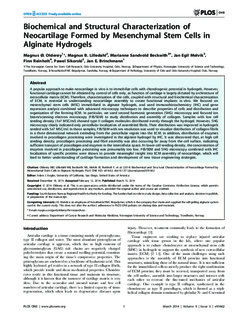| dc.contributor.author | Magnus Østgård, Olderøy | |
| dc.contributor.author | Lilledahl, Magnus Borstad | |
| dc.contributor.author | Beckwith, Marianne | |
| dc.contributor.author | Melvik, Jan Egil | |
| dc.contributor.author | Reinholt, Finn P. | |
| dc.contributor.author | Sikorski, Pawel | |
| dc.contributor.author | Brinchmann, Jan E. | |
| dc.date.accessioned | 2015-11-24T12:39:38Z | |
| dc.date.accessioned | 2015-12-09T12:48:06Z | |
| dc.date.available | 2015-11-24T12:39:38Z | |
| dc.date.available | 2015-12-09T12:48:06Z | |
| dc.date.issued | 2014 | |
| dc.identifier.citation | PLoS ONE 2014, 9(3):e91662 | nb_NO |
| dc.identifier.issn | 1932-6203 | |
| dc.identifier.uri | http://hdl.handle.net/11250/2367367 | |
| dc.description.abstract | A popular approach to make neocartilage in vitro is to immobilize cells with chondrogenic potential in hydrogels. However, functional cartilage cannot be obtained by control of cells only, as function of cartilage is largely dictated by architecture of extracellular matrix (ECM). Therefore, characterization of the cells, coupled with structural and biochemical characterization of ECM, is essential in understanding neocartilage assembly to create functional implants in vitro. We focused on mesenchymal stem cells (MSC) immobilized in alginate hydrogels, and used immunohistochemistry (IHC) and gene expression analysis combined with advanced microscopy techniques to describe properties of cells and distribution and organization of the forming ECM. In particular, we used second harmonic generation (SHG) microscopy and focused ion beam/scanning electron microscopy (FIB/SEM) to study distribution and assembly of collagen. Samples with low cell seeding density (1e7 MSC/ml) showed type II collagen molecules distributed evenly through the hydrogel. However, SHG microscopy clearly indicated only pericellular localization of assembled fibrils. Their distribution was improved in hydrogels seeded with 5e7 MSC/ml. In those samples, FIB/SEM with nm resolution was used to visualize distribution of collagen fibrils in a three dimensional network extending from the pericellular region into the ECM. In addition, distribution of enzymes involved in procollagen processing were investigated in the alginate hydrogel by IHC. It was discovered that, at high cell seeding density, procollagen processing and fibril assembly was also occurring far away from the cell surface, indicating sufficient transport of procollagen and enzymes in the intercellular space. At lower cell seeding density, the concentration of enzymes involved in procollagen processing was presumably too low. FIB/SEM and SHG microscopy combined with IHC localization of specific proteins were shown to provide meaningful insight into ECM assembly of neocartilage, which will lead to better understanding of cartilage formation and development of new tissue engineering strategies. | nb_NO |
| dc.language.iso | eng | nb_NO |
| dc.publisher | Public Library of Science | nb_NO |
| dc.title | Biochemical and Structural Characterization of Neocartilage Formed by Mesenchymal Stem Cells in Alginate Hydrogels | nb_NO |
| dc.type | Journal article | nb_NO |
| dc.type | Peer reviewed | en_GB |
| dc.date.updated | 2015-11-24T12:39:38Z | |
| dc.source.volume | 9 | nb_NO |
| dc.source.journal | PLoS ONE | nb_NO |
| dc.source.issue | 3 | nb_NO |
| dc.identifier.doi | 10.1371/journal.pone.0091662 | |
| dc.identifier.cristin | 1152133 | |
| dc.description.localcode | © 2014 Olderøy et al. This is an open-access article distributed under the terms of the Creative Commons Attribution License, which permits unrestricted use, distribution, and reproduction in any medium, provided the original author and source are credited. | nb_NO |
